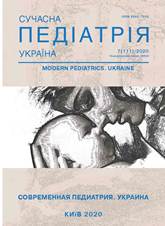Distance form of learning medical students as a challenge of today
Keywords:
distance learning, medical education, teacher, student, COVID-19 pandemicAbstract
A year has passed since humanity first encountered a previously unknown disease — COVID-19, which changed and made adjustments to the established mechanisms of human life. These changes also apply to the field of education, including medical education. Due to the quarantine imposed in Ukraine to prevent the spread of COVID-19, educational institutions were closed and students were transferred to distance learning. Organize quality online learning in a short period of time, charge motivation to learn and be prepared for technological problems — this is not a complete list of problems faced by teachers. However, the present can be called the era of computer science, telecommunications and global digitalization. The rapid rise of the integration of information and communication technologies, online tools in society in recent decades has become a preparation for solving problems and problems. Distance learning has advantages and disadvantages. In addition, there are several organizational and methodological and organizational and technical models of distance learning. Practical classes on pediatric therapeutic dentistry are held in the format of an online conference in the Microsoft Teams program (Pre-created Classes for each subgroup and events in the program — in the calendar according to the schedule, students are invited). Microsoft Teams is a teamroom for Office 365, which is a simplified version of learning management systems, but allows the learning team to communicate and share files. The program is convenient because it combines everything in a common work environment, which includes chat for discussion, file sharing and corporate programs. Students take each test topic in the system according to the calendar-thematic plan, get the result, which the teacher converts into points, according to the evaluation criteria. During the online lesson, the teacher interviews the topic, corrects the answer, explains the points that were unclear, using pre-loaded materials — presentations, videos, photos, radiographs and orthopantomograms, which helps to master the material. For future dentists, practical training, work with real patients, practice of manual and communication skills are extremely important, so during the remote teaching of pediatric therapeutic dentistry, situational problems are solved and algorithms of practical skills are analyzed in order to bring students closer to practice. Distance learning is a purposeful process of interaction between teacher and student, based on the use of modern information and telecommunications technologies that allow distance learning, which is relevant in a pandemic COVID-19.
References
Burmas NO, Boyko LA. (2019). System of distance learning at the Department of General Chemistry. Medical education. 2: 15-18. https://doi.org/10.11603/me.2414-5998.2019.2.10338
Galiy LV, Shulga LI, Yakushchenko VA, Nartov PV, Buryan KO, Bagan SO. (2019). Introduction of distance learning in the system of postgraduate education: problematic issues of today. Problems of continuing medical education and science. 3 (35): 14-20. https://doi.org/10.31071/promedosvity2019.03.014
Goncharova NG, Kirsanova OV, Svetlitsky AO. (2014). Implementation
of distance learning models in higher medical educational institutions.
Current issues of pharmaceutical and medical science and practice. 1
(14): 93—96.
Korbut OG. (2013). Distance learning: models, technologies, prospects. Naukovo-praktychna konferentsiia «Novitni osvitni tekhnolohii». Kyiv, 2013 Kyiv: Natsionalnyi tekhnichnyi universytet Ukrainy «Kyivskyi politekhnichnyi instytut imeni Ihoria Sikorskoho». URL: http://confesp.fl.kpi.ua/ru/node/1123.
Kovalchuk ZYA. (2012). Distance learning system in educational institutions of different types as a component of optimization of pedagogical interaction. Actual problems of sociology, psychology, pedagogy. 4 (17): 183—188.
Kucherenko N. (2018). Distance learning as a challenge of modern university education: philosophical and legal dimension. Bulletin of the National University «Lviv Polytechnic». Legal sciences. 20: 34—40.
Kushch OG, Omelyanchik VM, Bessarab GI. (2017). Distance learning in the system of medical education (the first experience of the Department of Normal Physiology of ZSMU). Medical education. 4: 85—89.
Machynska NO, Nagirnyak ME. (2009). Distance learning is the latest technology for training specialists in higher education. Information and telecommunication technologies in modern education: experience, problems, prospects: Collection of sciences. For ed MM Kozyara, NG Nychkalo. Lviv: LSU BJD. 1: 270.
Ministry of Education and Science of Ukraine. (2000). The concept of development of distance education in Ukraine of the 2020. Resolution of MES of Ukraine on December 20, 2000. URL: http://www.osvita.org.ua/distance/pravo/00.html.
Mironov YuB. (2020). Advantages and disadvantages of distance learning. URL: https://kerivnyk.info/perevahy-ta-nedoliky-dystantsijnoho navchannya-fbclidIwAR1jhqrr0ra4C8QOLKPnen_nZavaSTXQbsWHnDycw1I4Is3UbcQIX3ms2IA.
Skrypnyk LM. (2012). Distance medical education: modern realities and problems. Archive of clinical medicine. 2 (18): 116—118.
Virstyuk NG, Orynchak MA, Chovganyuk OS et al. (2020). Distance learning in the discipline of internal medicine for medical students in a pandemic COVID-19. Topical issues of improving the quality of the educational process: materials of the scientific-methodical conference with international participation, Ivano-Frankivsk, September 18, 2020. Ivano-Frankivsk: Ivano-Frankivsk National Medical University: 6.
Downloads
Published
Issue
Section
License
The policy of the Journal “MODERN PEDIATRICS. UKRAINE” is compatible with the vast majority of funders' of open access and self-archiving policies. The journal provides immediate open access route being convinced that everyone – not only scientists - can benefit from research results, and publishes articles exclusively under open access distribution, with a Creative Commons Attribution-Noncommercial 4.0 international license (СС BY-NC).
Authors transfer the copyright to the Journal “MODERN PEDIATRICS. UKRAINE” when the manuscript is accepted for publication. Authors declare that this manuscript has not been published nor is under simultaneous consideration for publication elsewhere. After publication, the articles become freely available on-line to the public.
Readers have the right to use, distribute, and reproduce articles in any medium, provided the articles and the journal are properly cited.
The use of published materials for commercial purposes is strongly prohibited.

